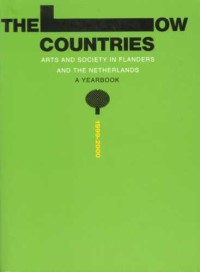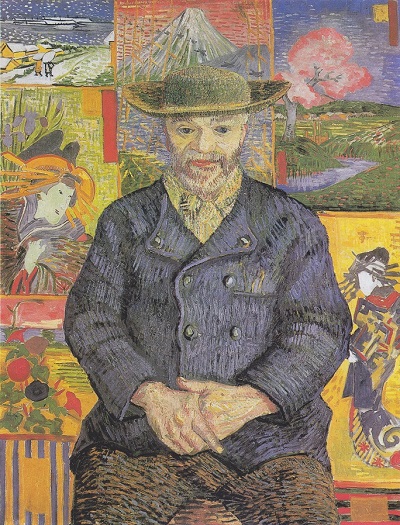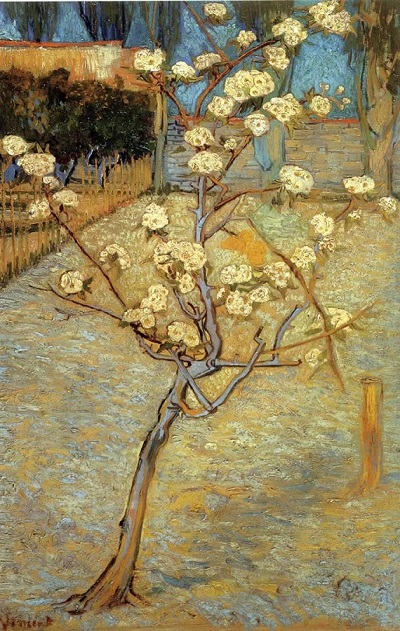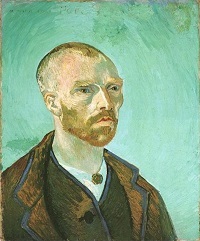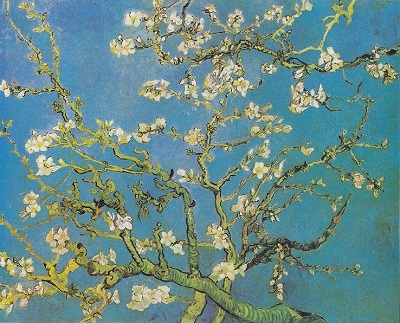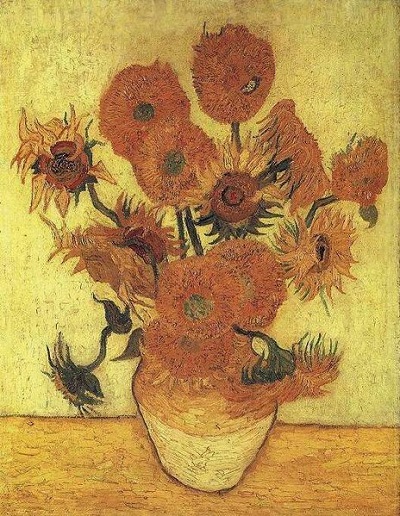But to return to Van Gogh and the start of his career. Having largely
taught himself to draw and paint, he had had little contact with colleagues,
and living in a remote village in Brabant did not improve his prospects
of interesting encounters either. Thus Vincent’s life was a fairly isolated
one. It was a stroke of luck that he was familiar with the latest developments
in Paris. Theo van Gogh was working there as an art dealer and sent magazines
and the latest books, such as those of Edmond and Jules de Goncourt, to
Brabant. These two brothers, whose reputation rests especially on their
diaries, considered themselves the discoverers of the Japanese art of printmaking.
The visit they made in 1861 to the Von Siebold collection in the Rijks Japansch
Museum in Leiden is proof of their serious interest. In their novels Japanese
art is often mentioned and Van Gogh, who was an avid reader, often referred
to these authors whom he admired. The Goncourts’ enthusiasm for Japanese
prints undoubtedly aroused his interest.
The first mention of Japanese art in his letters was in November 1885,
when Vincent, writing from Antwerp where he had just arrived, told Theo
that he felt at home in his small room because he had hung some Japanese
prints there: ’You know those little women’s figures in gardens, or on
the beach, horsemen, flowers, knotty thorn branches’. In the
same letter Vincent quotes a well-known motto of the Goncourt
brothers: ’Japonaiserie forever’. Little did he then know
how much those words would apply to himself.
The three months that Van Gogh spent in Antwerp served as a bridge between
the Brabant countryside and Paris. In the Netherlands his subject matter
had been scenes from the hard lives of peasants and weavers. When he arrived
in the French capital in February 1886, he was immediately confronted by
the innovative ideas of the avant-garde. Theo, of course, was a familiar
figure in the art world and Vincent soon came to know a number of the youngest
group of Impressionists. They were experimenting with new techniques like
pointillism. Anyone who calls The Potato Eaters to mind, painted
as Van Gogh himself declared in the tones of a ’dirty potato’,
can imagine how challenging he must have found the colourful canvasses
of Claude Monet, Camille Pissarro and
Alfred Sisley. But the painter of drab peasant life
was to make the colourful technique of the Impressionists his own in an
astonishingly short time.
With the enthusiasm so characteristic of him Vincent studied the stylistic
innovations of the Japanese printmakers. Together with Theo he accumulated
a large collection of Japanese prints and even organised an exhibition of
them in the café Du Tambourin, a
Montmartre venue for artists that was popular with the younger generation.
In 1885 the discerning critic Théodore Duret wrote:
’Prior to the discovery of the Japanese albums no one had had the nerve
to go and sit on the riverbank and allow a bright red roof, a white wall,
a green poplar, a yellow road and blue water to contrast with each other
on a canvas.’ Duret was especially delighted by the daring way in which
nature was represented in Japanese art. For the Impressionists, who were
out to rejuvenate the art of landscape painting, the Japanese print was
an inspiring example. Their revolutionary work was characterised not only
by a striking use of colour but also by other non-European features such
as figures abruptly cut off by the margin or an emphatic contrast between
what was in the foreground and the background.
Van Gogh familiarised himself with this idiom in his own way. In the
winter of 1887 he produced three ’Japonaiseries’: copies in oil of Japanese
prints. The most ambitious of the three was based on a reproduction on a
cover of the magazine Paris Illustré. The
issue was devoted to Japan and the print depicting an ’oiran’ (a
Japanese courtesan) has been identified as by Kesai Eisen. Van Gogh carefully
traced the figure on tracing paper, enlarged it and placed it in an idyllic
water landscape with bamboo and water lilies. He derived the two frogs and
cranes from two other Japanese prints. It is no accident that the cranes
are there. Vincent was indulging in some visual word play: ’grue’,
the French word for ’crane’, also means ’tart’, thus alluding to the
courtisane.
Another painting dating from the same period is the striking Portrait
of Père Tanguy. This dealer in artist’s materials
and art sympathised with the Impressionists, who found it hard to exhibit
their work. Père Tanguy allowed them the use of his
shop window and was also generous about offering artists credit. Van Gogh
was very fond of this Socialist Utopian, and Tanguy’s
kind-heartedness shines through in the painting.
As was frequently the case, Van Gogh made several versions of this portrait;
the Musée Rodin version shown here is the most elaborate.
Its relevance to this article is further enhanced by the presence in the
lower right corner of Van Gogh’s own ’Japonaiserie’ of the
oiran.
By now ’Japonism’ had come to mean more to Van Gogh than the obvious
stylistic int7uences in his own work. His image of Japan, and especially
of the way in which he believed that Japanese artists behaved towards each
other, had assumed the form of a Utopia. The disappointingly competitive
climate of the Parisian art world was no doubt also a factor. Van Gogh imagined
that instead of vying with each other Japanese artists worked together fraternally.
Someone like Père Tanguy, who was modest and
strove for a better society, fitted into that picture. This was a valid
reason for placing him against a background of Japanese prints.
Worn out and unwell after two taxing years in Paris, Van Gogh left for
Arles in the Spring of 1888. It was a wise decision, as the enthusiastic
letters he wrote after his arrival in the South of France show. To his colleague
Emile Bernard he wrote: ’Having promised to write to you I want to begin
by telling you that this countryside seems to me as beautiful as Japan for
clarity of atmosphere and gay colour effect.’ He also wrote to Theo
and his sister Wil that he felt as if he were in Japan.
A bonze in Arles
